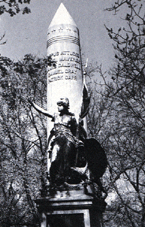Boston Massacre Monument

Public Art: Boston Massacre Monument
Sculptor: © Robert Kraus (August 5th, 1850 – November 7th, 1901)
Description: A 25ft circular granite column which at the top includes 13 stars and below, the names of the five men who died during the Boston riot of 1770; Crispus Attucks, Samuel Maverick, James (amended from Jonas) Caldwell, Samuel Gray, and Patrick Carr. Perched on the pedestal is a 7ft statue of Liberty. In her right hand, she clutches a broken chain and in her left a flag yet unfurled. By her left foot stands an American eagle.
Below the statue is a bronze bas relief of the engraving made famous by Paul Revere which was modeled on a drawing by Henry Pelham. In it, Crispus Attucks features in the foreground, as he was the first to fall. On one side is carved a quote from John Adams ” On that night the foundation of America was laid.” and the other a quote from Daniel Webster, “From that moment we may date the severance of the British empire.”
Date Unveiled: The monument was unveiled in 1888 followed by a parade. During the ceremony, a poem by John Boyle O’Reilly was read by Reverend Andrew Chamberlain.
Location: The Boston Massacre Monument is located on the Tremont Street side of the Lafayette Mall, Boston Commons, Boston Massachusetts, USA.
Background: The Boston Massacre (also called the Boston Riot) was an incident which happened on the 5th of March 1770, between the British Redcoats and five civilians. As the story goes, tension had been building in Boston for some time following the increase of British troops, who were there to enforce the Townshend Acts (a thinly disguise revenue-raising scheme).
It came to a head on King Street (now State Street) in the early evening of the 5th outside the Custom House when a young wigmaker’s apprentice named Edward Gerrish decided to rile a British Officer, Captain Lieutenant John Goldfinch. He began shouting at him that he hadn’t paid for his wig. Gerrish soon departed but returned a few hours later with some of his mates. This time, as well as throwing insults at Goldfinch the men began throwing rocks. Private Hugh White, a British sentry, who was standing duty outside the Custom House was the next to be targeted by Gerrish but he wasn’t so obliging. He left his post and struck Gerrick on the side of his head with his musket. The ensuing argument saw a crowd gather and that’s when the fight escalated.
The mob eventually grew to over 50 Bostonians who were all directing their anger at Private White and Captain Lieutenant Goldfinch. The British soldiers soon realized the situation was becoming volatile to say the least, so Private White left his sentry box and retreated to the Custom House. Meanwhile, Captain Thomas Preston who had been watching the events unfold from the Main Guard called for back up. Eight soldiers with fixed bayonets soon arrived and joined Private White at the Custom House stairs having pushed their way through the angry crowd now estimated be over 300.
The soldiers were pelted with snowballs, small objects and insults. At one stage one of the soldiers, Private Hugh Montgomery, was knocked to the ground with a club wielded by local tavernkeeper Richard Holmes. When he stood up he fired his musket. It is not clear if Captain Preston gave the orders to fire (as many of the revelers were taunting the soldiers to “fire”) but at some stage, the soldiers began shooting into the crowd. Eleven men were hit of which three died instantly. They were Crispus Attucks (the first to fall) a mixed-race sailor from Captain Folger’s whaleship of Nantucket, ropemaker Samuel Gray, mariner James Caldwell and a mixed-race sailor named Crispus Attucks. Samuel Maverick, a 17-year-old boy, who was struck by a ricocheting musket ball died the following day. Patrick Carr an Irish immigrant died two weeks later from his wounds.
Aftermath – Captain Preston and the soldiers were arrested and charged with murder. Not surprisingly no Boston lawyer wanted to defend the soldiers as it was a sure death sentence for their careers. In the end, the future President of the United States, John Adams, took the case. Admas argued that the men were acting in self-defense from a mob he described as “a motley rabble of saucy boys, negroes, and molattoes, Irish Teagues and outlandish jack tarrs,” The jury agreed and 6 of the soldiers were acquitted. However, two soldiers were found guilty of manslaughter as there was overwhelming evidence that they fired directly into the crowd. Adams somehow managed to have their death sentence overturned and instead they had a branding of thumb in open court. In their case an “M” for murder.
The Boston Massacre is considered to be one of the most important events that turned colonial sentiment against King George III and British acts and taxes which eventually lead to the American Revolution.
Boston Massacre Monument Trivia :
On the bas relief, the outstretched hand of Attucks has been rubbed down, as apparently rubbing it is considered good luck.
The sculptor Robert Klaus ended up dying in an asylum after he went insane following a meltdown over an incomplete sculpture of Belshazzar. Apparently, he couldn’t finish it due to lack of funds. The newspaper of the day claimed he died broken-hearted.